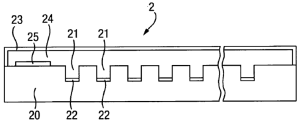This is an old revision of the document!
Table of Contents
1. Lipid Bilayer Sensor Array
Priority: April 20, 2009
Abstract
• You have an array of sensor elements.
• You have a bunch of detection channels capable of amplifying electrical signals from sensor elements.
• More sensor elements elements are provided than detection channels.
• Detection channels selectively connected to sensor elements.
• Connect only to sensor elements with acceptable performance quality.
• This improves efficiency of utilization of the detection channels.
• Results in reduction of cost and ability to perform sensing using relatively small samples.
1.1 Outline
• [0002] To perform sensing of molecular entities, it has been disclosed to use membrane proteins inserted in a lipid bilayer.
• [0005] The weak nature of the signals will require a separate detection channel for each sensor element which impacts cost.
• [0019] By selectively connecting the detection channels 30 to respective sensor elements it is possible to increase the efficiency with which the channels are used.
• [0020] The increase in efficiency arises due to the ability to select sensor elements that have acceptable quality of performance, for connection to a detection channel.
• [0025] This invention differs from time-division multiplexing (TDM) since its intend involves the redundant provision of sensor elements whose quality of performance varies. Thus events can happen faster than switching (unlike TDM) because the intention is to continuously attach to well performing sensors (once they are identified). The trouble must stem from the fact that the quality of sensor performance may be quite variable due to the need to form bilayers and insert member proteins which can vary every time such sensors are constructed (and construction might be done every few hours or even minutes I am guessing).
1.2 Sensor
 • [0044] Imagine the sensor device 2 consists of a large number (256 to 1024 typically) wells 21 with electrodes 22 arranged therein.
• [0044] Imagine the sensor device 2 consists of a large number (256 to 1024 typically) wells 21 with electrodes 22 arranged therein.
• [0046] Bilayers are formed across the wells and membrane proteins (i.e. nanopores) randomly inserted into each well's bilayer. Such spontaneous insertion is a dynamic process and so there is a statistical variation in the number of membrane proteins inserted into individual lipid bilayers, typically having a Poisson distribution.
• [0048] In the example below, acceptable quality of performance is the insertion of a single effective membrane protein, With plural membrane proteins being unacceptable. In other situations, insertion of plural effective membrane proteins may be acceptable.
1.3 Apparatus
• [0049] The wells are divided into groups. The picture uses 4 wells per group as an example. One detection channel per group is used. For some applications the sensor device might comprise a total of 4096 wells 21 and 1024 detection channels 30.

